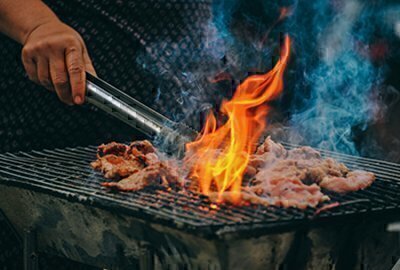Last updated May 2024

We love grilling and with good reason: Burgers, seafood, chicken, ribs, even otherwise yucky veggies are delicious cooked over an open flame. Whatever’s on your menu, everything tastes better with a heaping helping of safety. Here’s a recipe for safe grilling:
Fire safety (keep that char on the rib eye)
- Your grill’s owner’s manual includes important safety and usage directions. Please read it.
- Never use a charcoal or gas grill indoors.
- Position the grill out in the open, as far away from your house and other structures as possible. Keep it away from overhangs, overhead trees, and anything else that can ignite.
- Keep children and pets away from the grill area.
- Open the grill lid before turning on the gas. A closed lid can allow gas to build up inside your grill, which when lit can cause an explosion.
- Never use gasoline, kerosene, or other highly volatile fluids as a fire starter.
- Never add lighter fluid to an active fire.
- Wear fitted clothing to minimize the risk of your clothes catching fire.
- Use long-handled grilling tools to put plenty of distance between your hands and the heat.
- Periodically remove grease and other accumulated gunk from inside your grill and from trays below it. One in five grill fires is caused by a dirty grill.
- Don’t overload the grill, especially when cooking fatty meats. Excess grease can quickly ignite.
- Keep a charged fire extinguisher nearby. Know how to use it.
- Don’t leave a lit grill unattended.
Food safety (because salmon is yum, salmonella not so much)
- Keep it clean. Wash your hands, kitchen counters, cutting boards, and utensils often, especially after working with raw meat.
- To avoid cross-contamination, keep raw meat and eggs away from anything else you will be eating. When meat is cooked, put it on a clean plate.
- Rinse fruits and veggies under running water to remove bacteria.
- Keep meat, fish, and poultry at 40° F or below until just before cooking.
- Thaw frozen food in the refrigerator, not on the counter. If time is short, immerse packaged food in cold water to thaw, or thaw meat in the microwave.
- Marinate food in the refrigerator, not at room temperature, and don’t reuse marinade.
Be sure meat is thoroughly cooked. Use a meat thermometer to check that poultry is cooked to at least 165° F, hamburgers to 160° F, and other meats (steaks, roasts, chops, etc.) to a minimum of 145° F.

